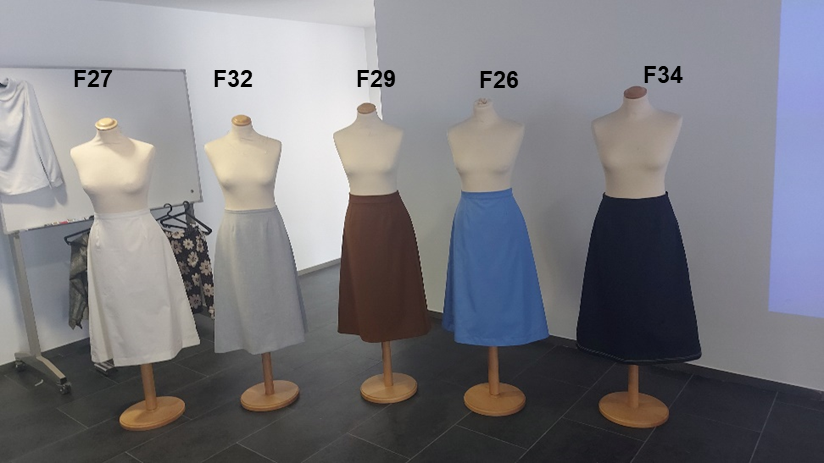Creation of databases for a virtual training library in fashion design
DOI:
https://doi.org/10.25367/cdatp.2024.5.p140-150Keywords:
Virtual fashion design, Virtual/physical fabrics, 3D Garments Physical garments Styles, Pattern designs Training platform, Fashion design elementsAbstract
A library of knowledge that contains a fabric database, 3D human body models database, and 3D garment database has been developed in the framework of the Erasmus+ project DigitalFashion – “Collaborative Online International Learning in Digital Fashion”, which is a collaboration of 6 European partners who would like to strengthen their working together through collaboration in online international teaching. The fabric database contains 49 physical textile fabrics, both woven and knitted fabrics. Each partner provided at least eight fabrics. The library contains also 3D human body models of different sizes (male, and female), and 48 pattern designs for women’s and men’s garments. The fabric’s physical and visual parameters have been determined using known textile standards, including their draping images taken using a Cusick Drape Tester. These fabric parameters have been used to predict the equivalent digital twin fabric based on Lectra digital fabrics, thereby completing the fabric database with their matching digital twin fabric. The digital twin fabrics have been used to simulate the 3D garments for the 3D garment database, based on the selected patterns and styles. To test the robustness of the fabric digitization process, a woman A-line skirt (real) was made by each partner using their fabric. These skirts were then compared with their simulated (virtual) skirts. The investigation has shown that the digital twin fabrics represent the real fabrics well. The virtual training library will support the specially developed training platform for virtual fashion design.
References
Baek, E.; Haines, S.; Fares, O.H.; Huang, Z.; Hong, Y.; Lee, S. H. M. Defining digital fashion: Reshaping the field via a systematic review. Computers in Human Behavior 2022, 137, 107407. DOI: https://doi.org/10.1016/j.chb.2022.107407.
Giri, C.; Jain, S.; Zeng, X.; Bruniaux, P. A detailed review of artificial intelligence applied in the fashion and apparel industry. IEEE Access 2019, 7, 95376-95396.
Bertola, P.; Teunissen, J. Fashion 4.0. Innovating the fashion industry through digital transformation. Research Journal of Textile and Apparel 2018, 22(4), 352-369.
Sun, L.; Zhao, L. Technology disruptions: exploring the changing roles of designers, makers, and users in the fashion industry. International Journal of Fashion Design, Technology and Education 2018, 11(3), 362-374.
Jevšnik, S.; Stjepanovič, Z.; Rudolf, A. 3D virtual prototyping of garments: Approaches, developments, and challenges. Journal of Fiber Bioengineering and Informatics 2017, 10(1), 51-63.
De Raeve, A.; Cools, J.; De Smedt, M.; Bossaer, H. Mass customization, business model for the future of fashion industry. In 3rd Global Fashion International Conference, Madrid, Complutense University, 2012; pp. 1-17.
Radulescu, I. R.; Dinis, A.; Malengier, B.; Cupar, A.; Blaga, M.; Polansky, R. E-learning course of software for textile design. In Proceedings International Conferences e-Society 2022 and Mobile Learning 2022, ISBN: 978-989-8704-38-2, 2022.
Grosu, C.; Radulescu, I. R.; Visileanu, E.; et al. Analysis of the learning requirements of less advantaged groups on the Romanian level. In Proceedings ICAMS 2022 – 9th International Conference on Advanced Materials and Systems, 2022. DOI: https://doi.org/10.24264/icams-2022.VI.2
Abram Zver, M.; Stjepanovič, Z.; Kapel, J. Comparing the appearance of virtual and real woman's dress. In Annals of DAAAM & Proceedings of the 21st International DAAAM Symposium, 21(1), 2010.
Rudolf, A.; Cupar, A.; Stjepanovič, Z. Designing functional garments for people with physical disabilities or kyphosis by using computer simulation techniques. Industria Textila 2019, 70(2), 182-191.
Yordan, K. Material description for textile draping simulation: data structure, open data exchange formats and system for automatic analysis of experimental series. Textile Research Journal 2022, 92(9-10), 1519-1536. DOI: https://doi.org/10.1177/00405175211061192
Vizoo – Fabric Textures and 3D Digitization at its Best. 2022. https://www.vizoo3d.com/physx-platform/ (accessed 07-02-2024).
About U3M – Fabric Digitalization Browzwear | Browzwear. 2024. https://www.u3m.info/ (accessed 07-02-2024).

Downloads
Published
How to Cite
Issue
Section
License
Copyright (c) 2024 Sheilla Odhiambo, Alexandra De Raeve, Cosmin Copot; Ion Razvan Radulescu; Andreja Rudolf, Tadeja Penko, Xianyi Zeng, Xuyuan Tao, Thu-Ha Do, Alexandra Cardoso, Irina Ionescu, Joris Cools

This work is licensed under a Creative Commons Attribution 4.0 International License.





